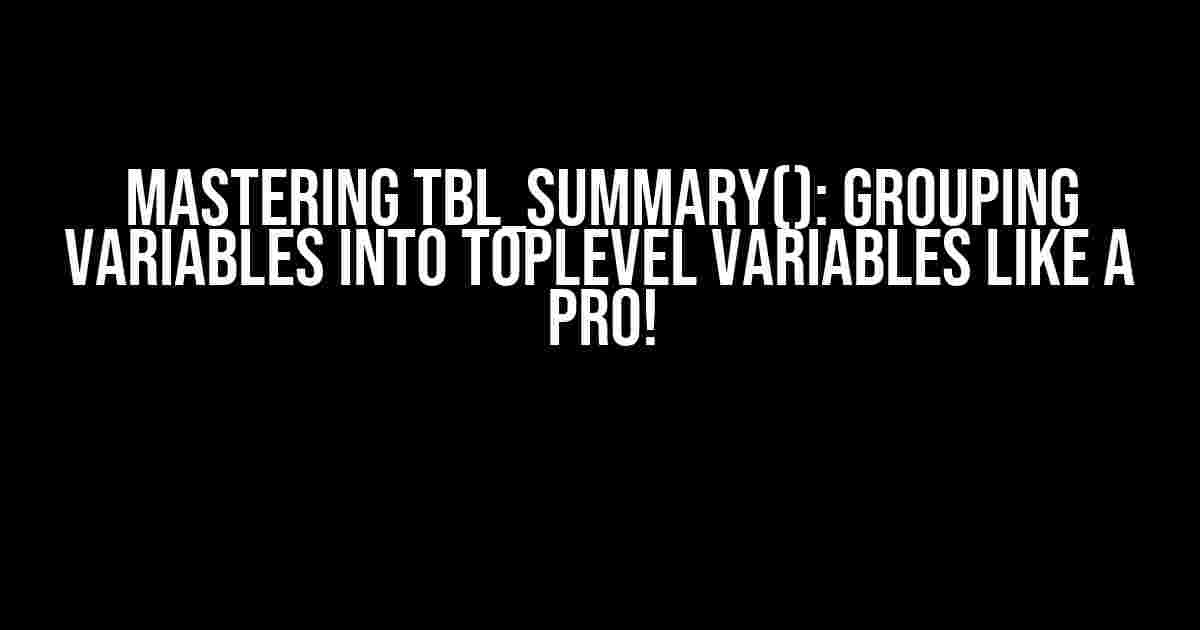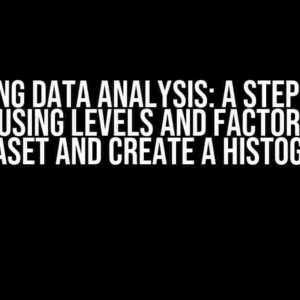Welcome to the world of data manipulation and summarization! Today, we’re going to dive into the fantastic universe of tbl_summary() and explore one of its most powerful features: grouping variables into toplevel variables. Get ready to unlock the full potential of your data and take your summary tables to the next level!
What are Toplevel Variables?
Before we dive into the nitty-gritty of grouping variables, let’s quickly cover what toplevel variables are. In the context of tbl_summary(), toplevel variables refer to the main columns or variables in your dataset that you want to summarize or describe. Think of them as the “headlining” variables that will be displayed prominently in your summary table.
For example, if you’re working with a dataset about customers, some toplevel variables might include:
- Customer ID
- Age
- Gender
- Country
These variables are the foundation of your summary table, and the ones you’ll want to group other variables under.
Why Group Variables into Toplevel Variables?
Now that we’ve covered what toplevel variables are, let’s talk about why grouping variables into them is so powerful. By grouping variables into toplevel variables, you can:
- Simplify complex data: Grouping variables helps to organize and structure your data in a way that’s easy to understand and work with.
- Reduce data clutter: By grouping related variables together, you can eliminate clutter and make your summary table more concise and readable.
- Enhance data insights: Grouping variables allows you to focus on the most important aspects of your data, making it easier to identify trends, patterns, and correlations.
- Improve data visualization: With grouped variables, you can create more effective and informative visualizations that tell a clear story about your data.
How to Group Variables into Toplevel Variables using tbl_summary()
Now that we’ve covered the why, let’s get to the how! To group variables into toplevel variables using tbl_summary(), you’ll need to follow these steps:
Step 1: Prepare Your Data
Before you can start grouping variables, you need to prepare your data by:
- Loading the
gtsummarypackage:library(gtsummary) - Loading your dataset:
data(your_data) - Converting your data to a tibble:
your_data %>% as_tibble()
> library(gtsummary)
> data(mtcars)
> mtcars %>% as_tibble()Step 2: Identify Your Toplevel Variables
Next, identify the toplevel variables in your dataset that you want to group other variables under. For our example, let’s say we want to use the cyl, vs, and am columns as our toplevel variables.
> toplevel_vars <- c("cyl", "vs", "am")Step 3: Group Variables into Toplevel Variables
Now, use the tbl_summary() function to group variables into your toplevel variables. You can do this using the by argument, which specifies the toplevel variables to group by.
> mtcars %>%
tbl_summary(by = toplevel_vars)This will create a summary table with the toplevel variables as the main columns, and the remaining variables grouped underneath.
Customizing Your Summary Table
Once you’ve created your summary table, you can customize it to fit your needs. Here are a few ways to do so:
Adding Additional Variables
Use the add_n() function to add additional variables to your summary table. For example:
> mtcars %>%
tbl_summary(by = toplevel_vars) %>%
add_n(label = "Number of Rows")Modifying Variable Labels
Use the modify_header() function to modify the labels of your variables. For example:
> mtcars %>%
tbl_summary(by = toplevel_vars) %>%
modify_header(cyl = "Cylinders", vs = "V/S", am = "Automatic/Manual")Changing the Summary Statistics
Use the add_stat() function to change the summary statistics displayed in your table. For example:
> mtcars %>%
tbl_summary(by = toplevel_vars) %>%
add_stat(funs = list(mean, sd))Putting it All Together
Let’s put everything we’ve learned together in a single example:
> library(gtsummary)
> data(mtcars)
> mtcars %>% as_tibble() %>%
tbl_summary(by = c("cyl", "vs", "am")) %>%
add_n(label = "Number of Rows") %>%
modify_header(cyl = "Cylinders", vs = "V/S", am = "Automatic/Manual") %>%
add_stat(funs = list(mean, sd))| Cylinders | V/S | Automatic/Manual | mpg | disp | hp | drat | wt | qsec |
|---|---|---|---|---|---|---|---|---|
| 4 | 0 | 0 | 26.00 (4.51) | 105.14 (26.41) | 82.64 (20.93) | 3.77 (0.39) | 2.29 (0.43) | 19.13 (1.87) |
| 4 | 1 | 0 | 28.40 (4.47) | 102.88 (22.47) | 75.80 (18.80) | 3.91 (0.50) | 2.27 (0.42) | 18.60 (1.67) |
And that’s it! With these simple steps, you’ve successfully grouped variables into toplevel variables using tbl_summary(). From here, the possibilities are endless – you can customize your summary table to fit your specific needs, explore your data in new and exciting ways, and uncover insights that might have otherwise gone unnoticed.
Conclusion
Mastering the art of grouping variables into toplevel variables is a crucial step in summarizing and visualizing your data. With the powerful tbl_summary() function and the techniques outlined in this article, you’re now equipped to take your data analysis to the next level. Remember to keep it simple, stay organized, and always keep your toplevel variables in mind – happy summarizing!
Here are 5 Questions and Answers about “Group variables into toplevel variables within tbl_summary()” in a creative voice and tone:
Frequently Asked Question
Get the most out of your data summaries with these FAQs on grouping variables into toplevel variables within tbl_summary()!
Q1: What is the purpose of grouping variables into toplevel variables within tbl_summary()?
The purpose of grouping variables into toplevel variables within tbl_summary() is to organize and simplify complex data summaries by combining related variables into a single, higher-level variable. This makes it easier to analyze and interpret the data.
Q2: How do I specify which variables to group in tbl_summary()?
You can specify which variables to group by using the `group` argument within tbl_summary(). For example, `tbl_summary(data, group = c(“var1”, “var2”))` would group variables “var1” and “var2” into a single toplevel variable.
Q3: Can I customize the name of the toplevel variable in tbl_summary()?
Yes, you can customize the name of the toplevel variable by using the `label` argument within tbl_summary(). For example, `tbl_summary(data, group = c(“var1”, “var2”), label = “My Toplevel Variable”)` would name the toplevel variable “My Toplevel Variable”.
Q4: How do I specify the order of the variables within the toplevel variable in tbl_summary()?
You can specify the order of the variables within the toplevel variable by using the `order` argument within tbl_summary(). For example, `tbl_summary(data, group = c(“var1”, “var2”), order = c(“var2”, “var1”))` would put “var2” first and “var1” second within the toplevel variable.
Q5: Are there any limitations to grouping variables into toplevel variables within tbl_summary()?
One limitation is that you cannot group variables with different data types (e.g., numeric and character) into the same toplevel variable. Additionally, the grouped variables must be present in the original data frame for tbl_summary() to work correctly.




